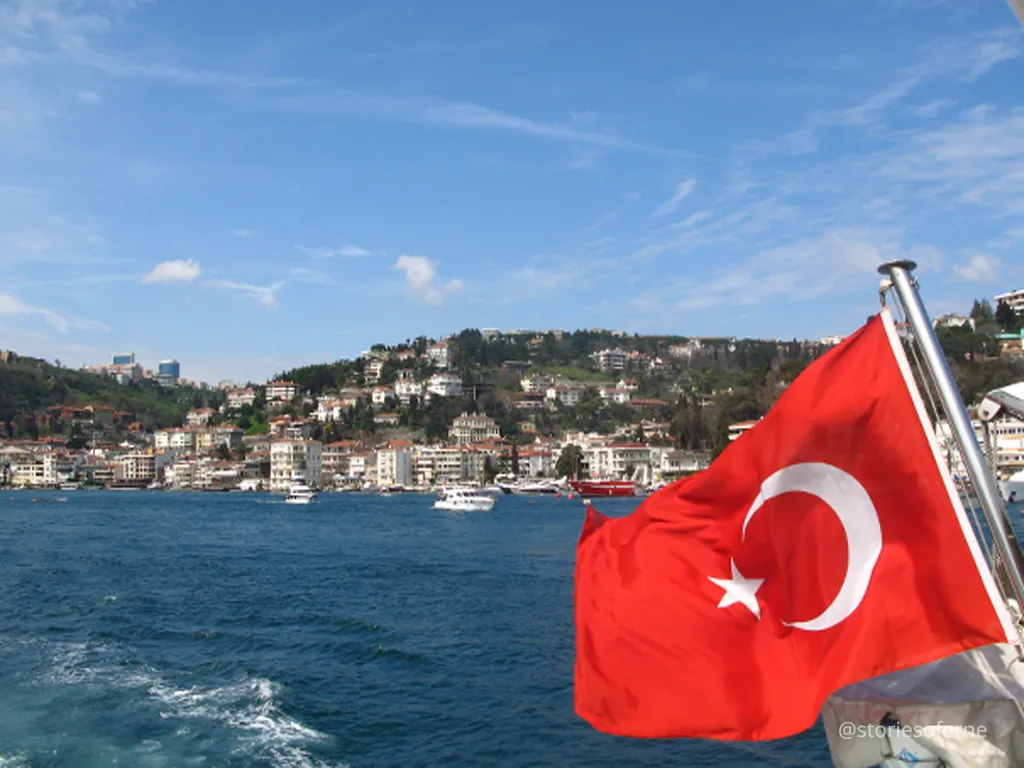
The destination's name and location aren't mentioned in my blog post's headline. Does that make you curious about where this place is?
Hint: It's where Europe and Asia collide.
If the country of Turkey was on your mind, you're absolutely correct! However, for this special trip, we'll be focusing more on a specific sea channel between these two gigantic continents.
As an avid traveler myself, I was truly excited to have landed on this part of our planet. With my explorative nature, I love discovering sites that are filled with geographical, cultural, and historical splendor. And Turkey happens to be a nation full of these incredible wonders!
So get ready as I take you on a pleasurable boat cruise that I've experienced along a well-known body of water situated at the heart of the ancient Turkish city of Istanbul.
The Historic Waterway: Bosphorus Strait

With its glittering greenish-blue stream, the Bosphorus Strait, as it's officially called, is not your ordinary aquatic environment. Given its strategic geography, this significant stretch of water dwells at the crossroads of multiple civilizations, social transitions, and cultural diversities.
The Bosphorus Strait holds tremendous geographical significance because it's where the landmasses of the European western side and the Asian eastern side meet.
The entire expanse of this canal spans 32 kilometers (20 miles) in length, 730-3300 meters (800-3600 yards) in width, and 30-120 meters (100-395 feet) in depth. It's a natural strait and is the world's narrowest canal used for international seafaring routes.
Fishing boats, yachts, ferries were in abundance, a commercial oil tanker, a massive ocean liner traversed daily through its challenging waves. Yet, this sea channel doesn't reveal the dark clouded water we would expect from its frequent industrial use.
Because this nation is extremely rich in the historical landmarks you can visit, the Bosphorus boat tour may be overlooked by some travelers. But, go ahead and squeeze in a couple of hours from your busy travel schedule to taste this fascinating cruise. Take my advice - it's an experience you won't regret!
Our Starting Point: Eminonu Pier

Before I hopped on the ferry ride, allow me first to show you around the bustling port area of Istanbul's Golden Horn waterway where the Eminonu Pier, Galata Bridge, and neighboring urban spaces of our journey would begin. Places like these were always occupied by several people from all walks of life. Hence, chaos was expected, yet in a cultured manner.
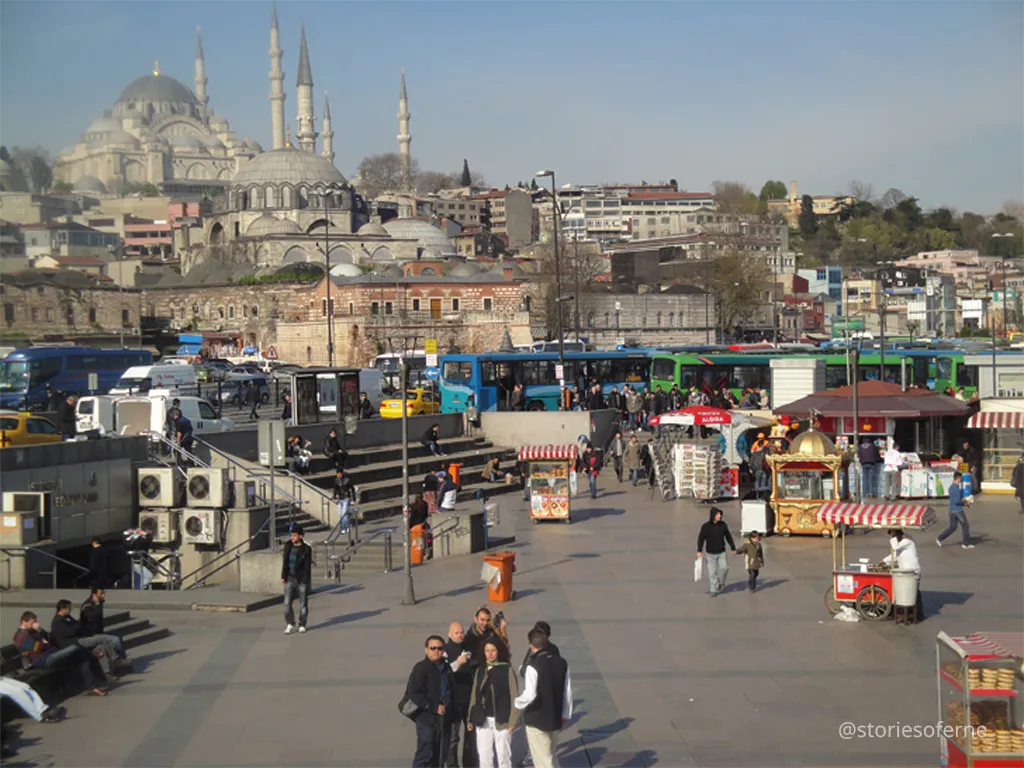

Typical of port areas around the globe, individuals usually arrive on foot, by boat, by tram, and by other means of transportation at the Eminonu Pier. There's an outpouring of different levels of noise and other sounds, smells, and rapid activities. This is an extremely busy place.

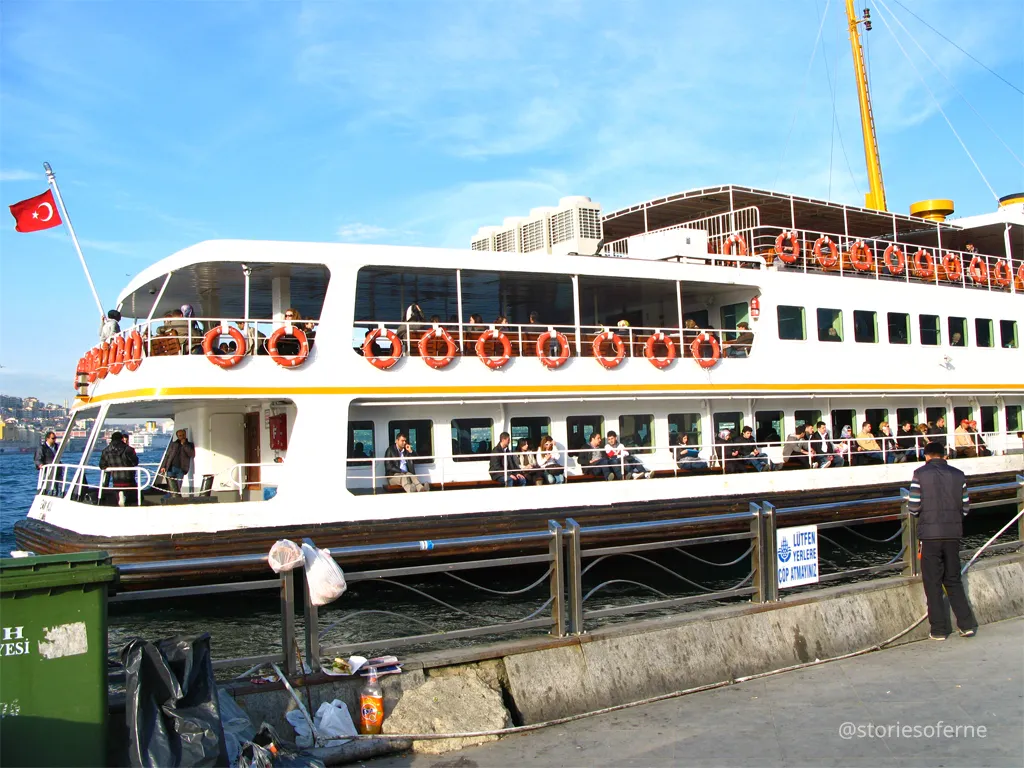
The Eminonu district where the vibrant pier with the same name was situated, was a former district of Istanbul, and currently occupied a quarter of today's Fatih district. This historic part of the vibrant metropolis used to be the heart of the walled city of Constantine and also covered a land area where the ancient city of Byzantium was constructed.


Standing on a historic site like Eminonu sent shivers down my spine. It's indeed a privilege to have visited a place with so many interesting stories. If you're a tourist here, you'd immediately feel at home due to the lively and colorful atmosphere you'd encounter here.
The Many Faces of Galata Bridge

Adjacent to the Eminonu Pier was the historic Galata Bridge. Here, I was impressed by the amount of people that crossed this relatively short link between the districts of Eminonu and Karakoy.

Spanning the water channel of the Golden Horn, the history of this bridge began in 1845. It has gone through many transformations over the years and was recently destroyed by fire in 1992. Nevertheless, it remains to be one of Istanbul's most iconic symbols of city life. As I passed through it, some visible activities that caught my eyes were the people fishing along the edge of the bridge. It was a wonderful sight, and I didn't hesitate to investigate them further.


There were a variety of sea creatures that can be harvested from the Bosphorus Strait. Atlantic bonito, sand smelt, bluefish, European pilchard, and needlefish were the main migratory fish that traverse through its waters. Its regular inhabitants were black scorpionfish, annular bream, mullet, pickerel, horse mackerel, brown meagre, red gurnard, and sea bass, can be caught all year round.

It's a wonderful sight to see the locals and different individuals having fun while fishing on the Galata Bridge. While at the bridge, I also admired the surrounding views of the city like the famous Galata Tower which can be seen on the skyline.
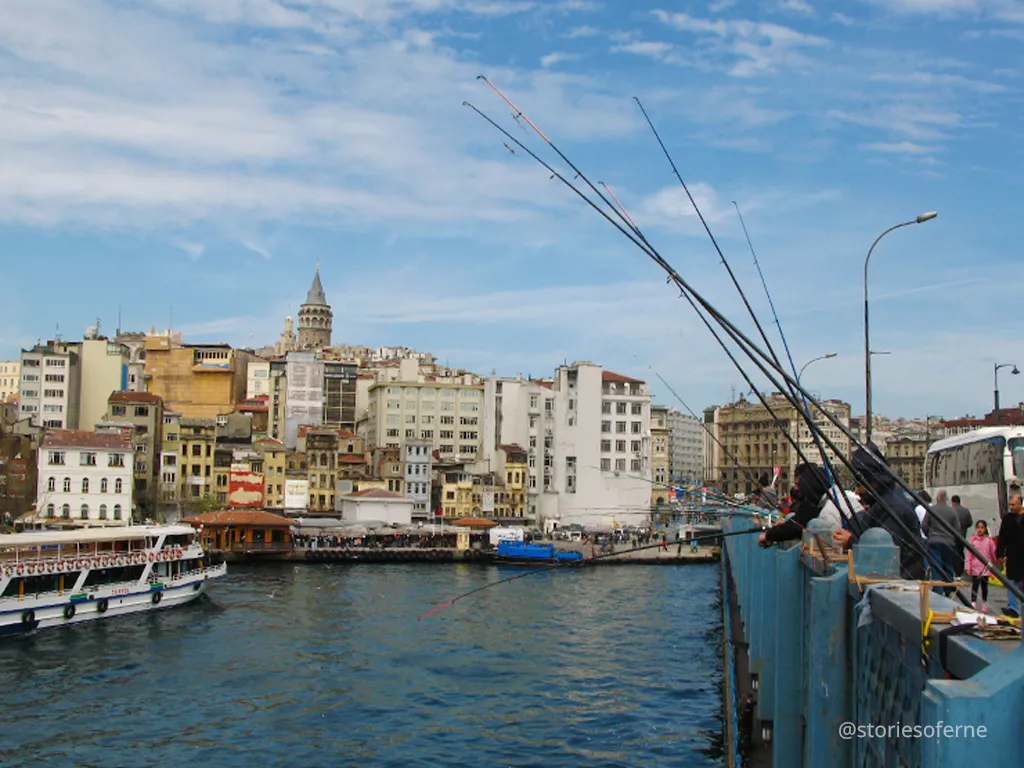
The Turkish people are a friendly race, and for that reason, I didn't miss taking a memorable photograph with one of them. The magnificent Suleymaniye Mosque can be admired from the bridge with its spectacular view shown behind us.

Aside from the mass of people passing through the bridge by foot, public and private vehicles, a tramway system conveniently passes over the bridge and through the busy road networks of the city.

The lower levels of the bridge can be accessed through a hidden stairway enclosed in a boxed tower. This was where I proceeded downstairs to explore business establishments, restaurants, cafes, and other tourist joints. While I passed my time here, I also enjoyed the bustling waters of the Golden Horn plus the amazing views of the city.
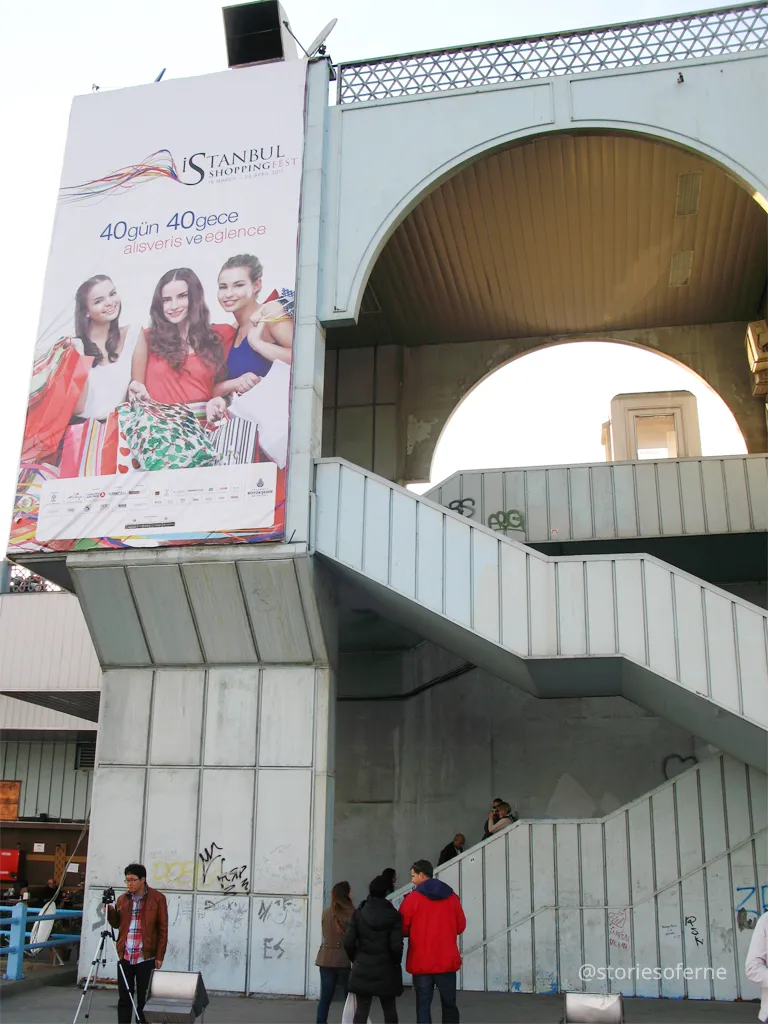
Life on the Galata bridge was vibrant and was filled with activities for tourists and locals alike. You'd never get bored as there are a lot of things to do here.


The Galata Bridge is a significant symbol of Istanbul's urban features. Together with the road vendors, people fishing, plus ferries docking and passing underneath, it's an ideal glimpse of daily life in the city.
Immersing in the Bosphorus

I've included a map for your easy reference. The popular landmarks were clearly marked with their names and approximate locations along the coast of the Bosphorus.
Now, it's time to take our ferry cruise. This tour took me roughly around 2 hours to complete. Tickets for the ferry cruises varied depending on the trip duration and selected itineraries and were available at the docks of the Eminonu Pier. I started off at the ferry boarding gates to get ready for the trip. What an exciting day it was!
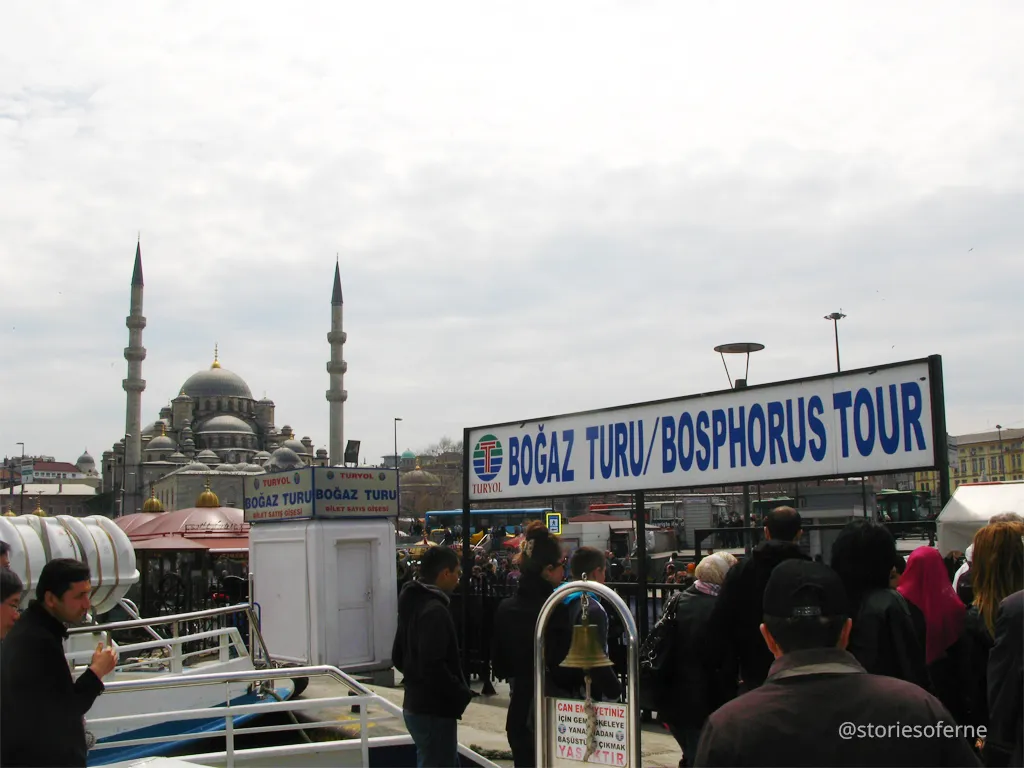
This was how a typical ferry looked like for this particular cruise. It has two levels separating the lower deck (covered space) and the viewing deck above to enjoy a 360-degree view of the city's landmarks along the coastline.



The vibrant districts of Eminonu (Suleymaniye Mosque in the background) and Karakoy (Galata Tower in the skyline) can be conveniently viewed from the ferry.
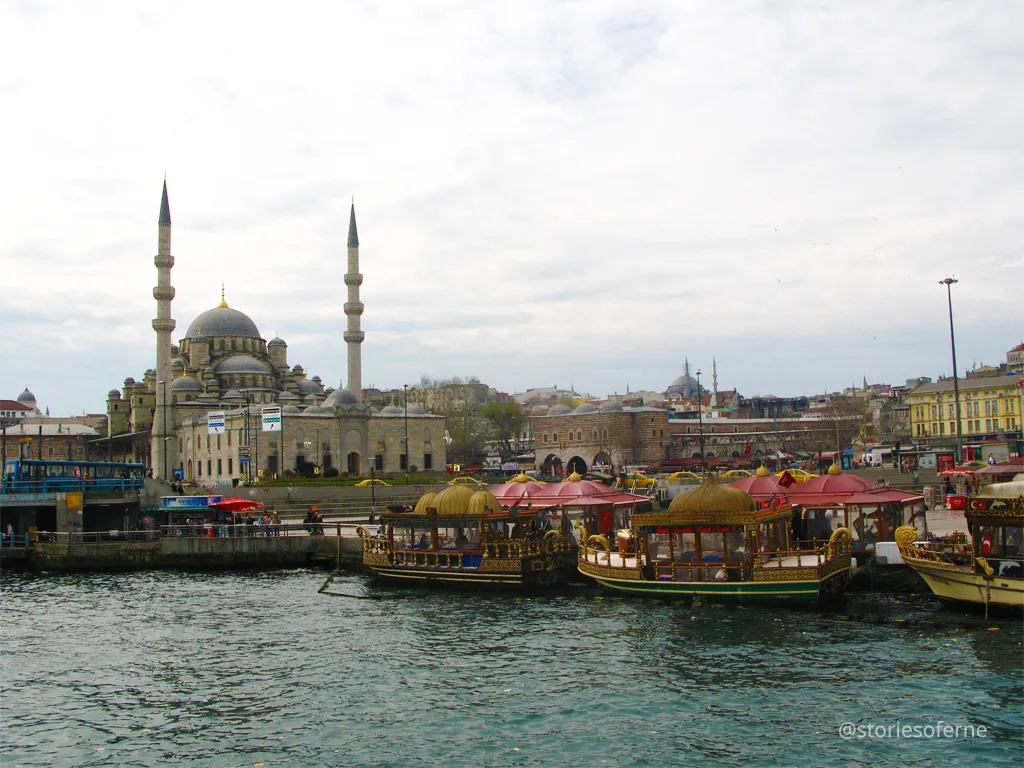

As these vital attractions and pieces of history were already exceptional in their own right, you could visit them individually to learn more. Indeed, these amazing locations were already special destinations in themselves. I'll only be sharing with you their fundamental details about their significance without diving too much on further descriptions.

For this particular trip, we'll just be appreciating them from a distance as they were viewed from the Bosphorus waterway. There were many interesting stories attached to these historic spots along this sea channel. And my excitement continued to pump as the ferry gained speed on the waterway! So here we go.
Maiden's Tower (Kiz Kulesi)
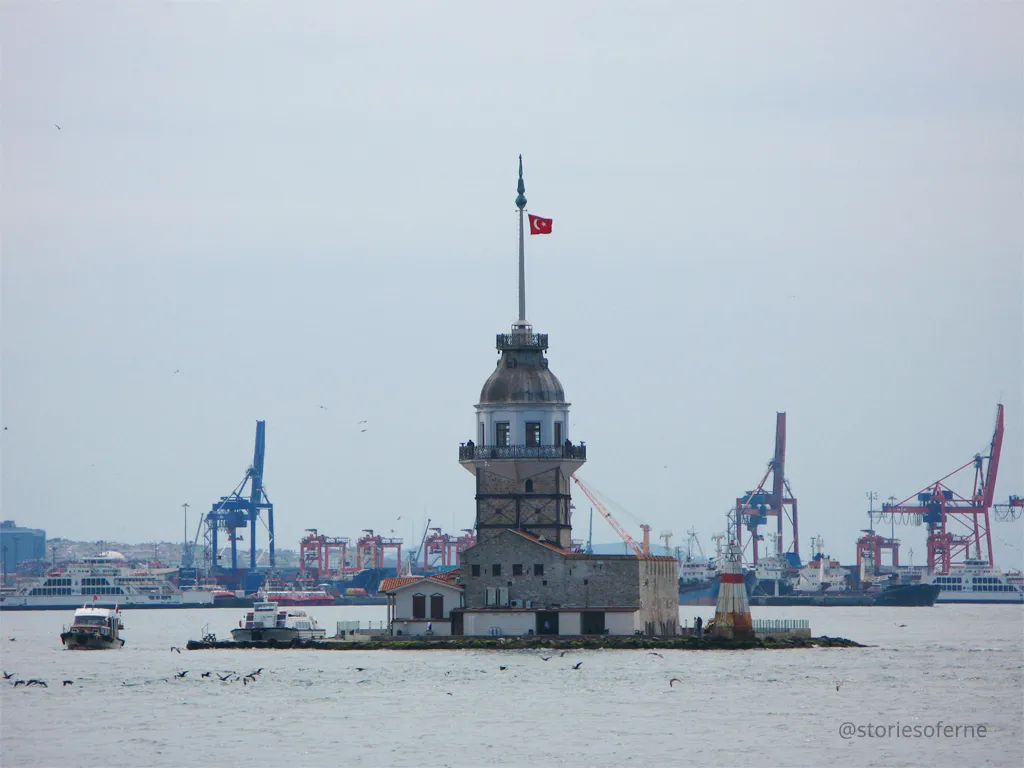
This islet (tiny island) situated approximately 200 meters (650 feet) from the coast of Uskudar, was closer to the Asian side and sat at the southern entrance of the waterway. It has a rich history that dated back to the fourth century. Being an iconic emblem, this tower also had its share of folklore and legends.
However, what's important were the historic tales embedded with it. The Maiden’s Tower embodied many different functions throughout the centuries, including a small fort (defense tower), a tax collection center, and a lighthouse. This landmark was previously recognized as Leandros and Damalis, named after the wife of Kharis the king of Athens during that time. It was given the name of "Arcla" which means "Little Castle" during the Byzantine era.
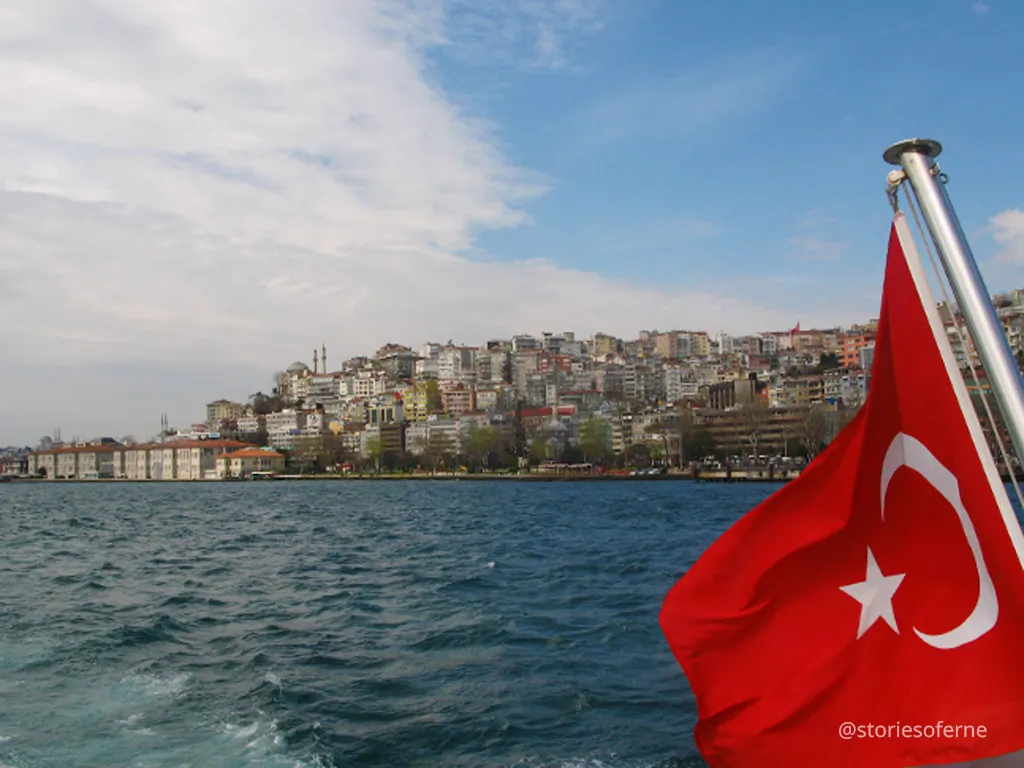
As I cruised along the waterway, the European side of the Bosphorus Strait can be admired with its amazing skyline filled with interesting architecture.
Dolmabahce Mosque

This mosque can be seen on the European side of the coastline of the strait.

Its original construction was supported by Bezm-i Alem Valide Sultan. After her death, her son by the name of Sultan Abdulmecid, completed its building until it was opened for prayer services in 1855.
Dolmabahce Palace

This strikingly beautiful two-floor piece of architecture covered a massive area of land that incorporated 285 rooms, 44 halls, 68 toilets, and 6 bathrooms. It's currently Turkey's largest mono-block palace rendered in a design mixture of Baroque, Rococo, Neo-Classic and traditional Ottoman art and culture. It was commissioned by the Sultan Abdul Mecit in 1843 to contradict the military and economic power of the Ottoman Empire. This is proudly Istanbul's first European-style palace because of its excessive luxury, extravagant size, and was decorated with gold and crystal.

Dolmabache is translated as "Filled Garden" Although the area where this palace stood used to be a small bay, it was slowly covered to give way to an Imperial Garden along the Bosphorus coastline.
You'll be dazzled by the richness and wealthy atmosphere of this magnificent piece of architecture.
Ciragan Palace

Today this ancient palace is converted to a sophisticated hotel called the Ciragan Palace Kempinski. Also located along the shorelines of the Bosphorus, this building for royalty was combined as a hotel and offered luxurious and glamorous living on an authentic Ottoman imperial palace.

The surrounding amenities also included a splendid wide garden with palm trees to enrich your view over the magnificent coastline.
Ortakoy Mosque

This mosque, built between 1853-1855, was also called the Mecidiye Mosque and was built by Sultan Abdulmecid. This iconic Islamic place of worship represented the ultimate symbol of Ortakoy in Istanbul and is an exemplary example of Baroque style during the eclectic period of Ottoman architecture.

This was definitely one of the eye-catching buildings during the boat tour because it's situated close to the Bosphorus bridge and also along the edge of the coastline.
Bosphorus Bridge (15 July Martyrs Bridge)

This prominent bridge that spans the western and eastern sides of the Bosphorus was officially named as 15 July Martyrs Bridge. It's one of the 3 major suspension bridges in this strait. This important land link connects the districts of Ortakoy (in Europe) and Beylerbeyi (in Asia).

During a coup d'etat attempted by a band of soldiers who took control of the bridge on July 15, 2016, this significant event prompted Turkey's Prime Minister Binali Yıldırım to make the decision of renaming this landmark to July 15th Martyrs Bridge to honor the memory of those who died by resisting the military takeover.

The Bosphorus Bridge currently holds the 33rd-longest suspension bridge span in the world.
Beylerbeyi Palace

Constructed on orders of the Ottoman Sultan Abdulaziz (1861-1876), the Beylerbeyi Palace was a small summer palace along the Asian side of the Bosphorus coastline. This ornate imperial residence had a fountain in the salon, grand rooms, lush chambers with their Bohemian-style crystal chandeliers, Chinese vases, and adorable gardens.


Historically, this palace was frequently opened as a guesthouse for visiting members of royalty. Grand Duke Nicholas of Russia, Shah Nasruddin of Persia, and Eugenie of France were some of the few visitors who delighted in its comfortable spaces.
Kuleli Military High School (Kuleli Askeri Lisesi)

The Kuleli Military High School building and surrounding complex was known to be the oldest military high school in Turkey. It's situated in Cengelkoy, Istanbul along the Asian coastline of the Bosphorus Strait. It was built on September 21, 1845 and was founded by Ottoman Sultan Abdulmecid I.
Kucuksu Palace (Kucuksu Kasri)

Another small summer pavilion (Goksu Pavilion), this was situated along the Asian shoreline and located at the Kucuksu neighborhood in the Beykoz district of Istanbul. This important building was utilized by the Ottoman sultans for their short stays, hunting expeditions, and country outings.
Water Vessels on the Bosphorus

This busy sea channel was littered with water vessels of all kinds. There were commercial ferries, private yachts, large cruise liners, small speed boats, and international tankers that passed through this busy sea route.

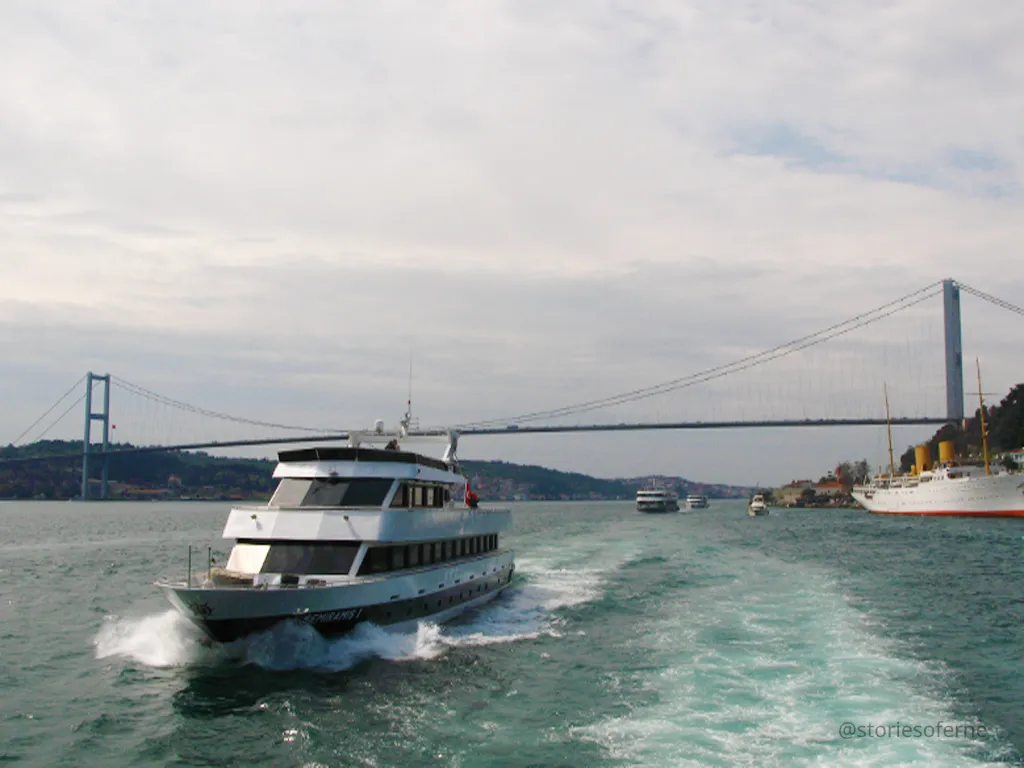
Ottoman Yali Mansions
The term "Yali" means a mansion that's built along the edge of the coastlines. These prominent residences and buildings were scattered all over the coastlines of the Bosphorus Strait. And they were an absolute sight to behold - a variety of architectural styles mixing European and Asian design influences.











Anatolian Fortress (Anadolu Hisari)
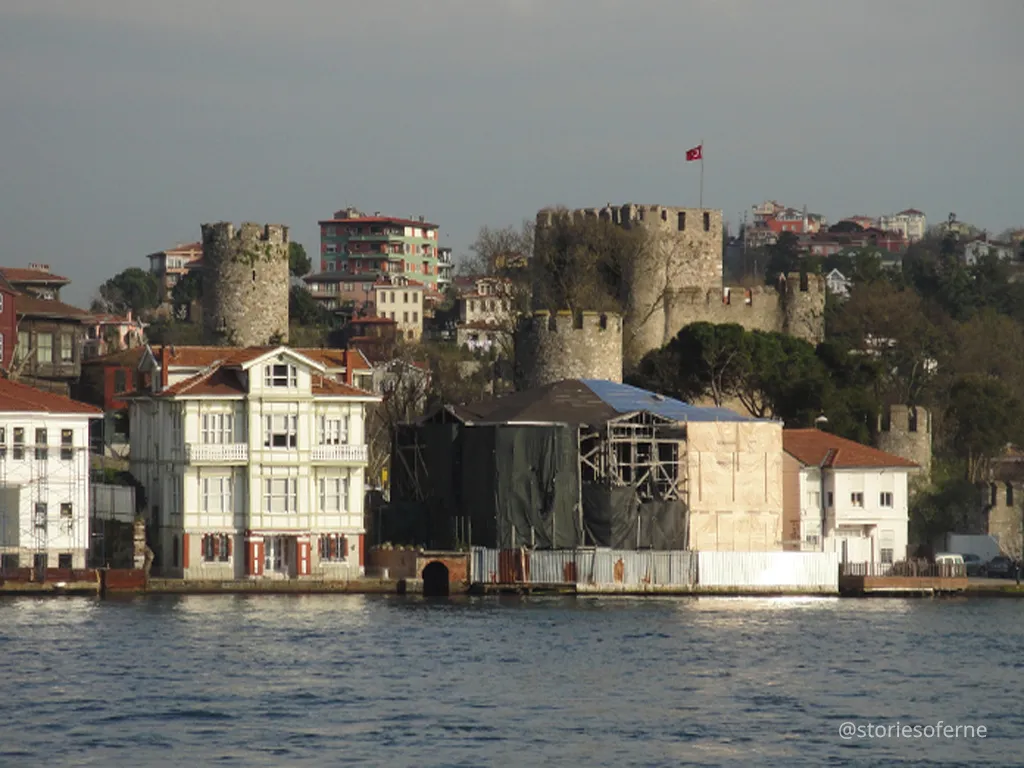
This medieval fortress located at Istanbul's Beykoz district was recognized historically as Guzelce Hisari "The Beauteous Castle" and was along the Asian edge of the Bosphorus. The ancient complex of this city was the oldest surviving structure with a Turkish architectural style.

Rumeli Fortress (Roumeli Hissar Castle)

This ancient building was a medieval fortress situated on a series of hills along the European banks of the Bosphorus. Located in the Sanyer district, the fortress also offered its name to its surrounding neighborhood.


Built between 1451 and 1452 and commissioned by Ottoman Sultan Mehmed II, this complex was constructed in preparation for the prepared siege of the former Byzantine city of Constantinople. Its mission was to cut off military supplies and logistical aid that would come to the Byzantines through the Bosphorus Strait. After the Ottoman conquest of this city, this fortress served as a prison and customs checkpoint for Embassies of states that were not in good terms with the empire.
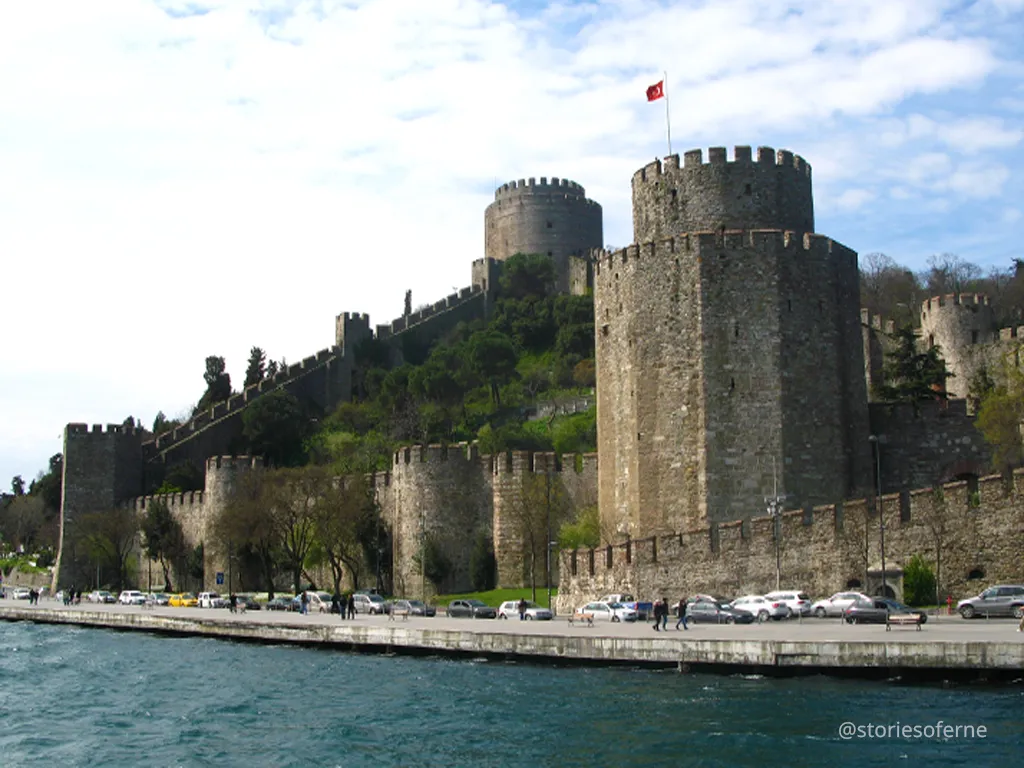


Today, it's a popular museum, and occasionally serves as an open-air venue for festivals, concerts, and other special events.
Fatih Sultan Mehmet Bridge
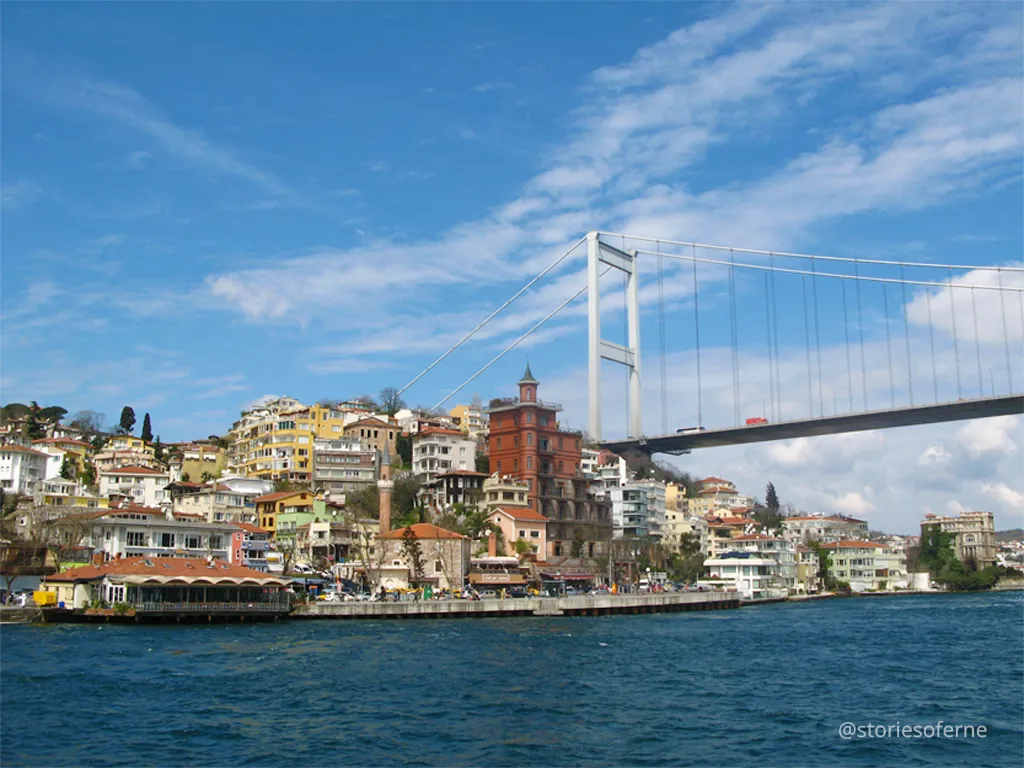
Also known as the Sultan Mehmed the Conqueror Bridge, this second bridge along the Bosphorus was completed in 1988, and was the world's 5th longest suspension bridge span during that time. Now, it holds the title of 24th in rank.

What's remarkable about this bridge was that there's an array of interesting buildings, houses, and structures built close to it producing a picturesque effect in the city's beautiful skyline.
Return to Port of Origin
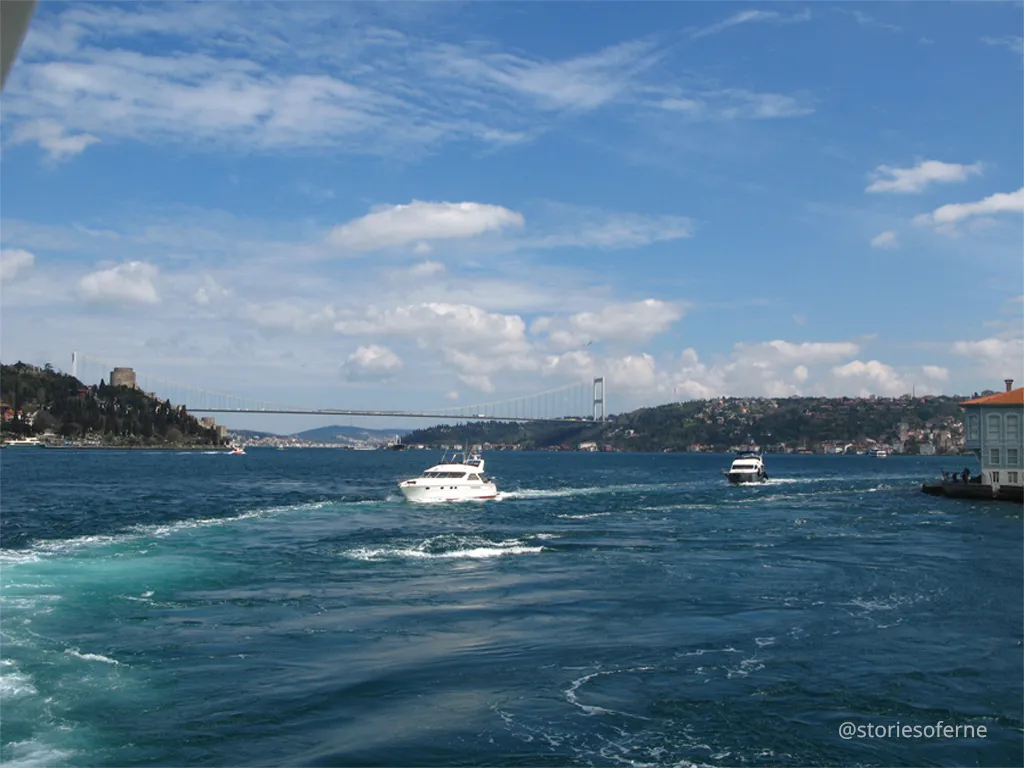
On my way back to Eminonu Pier, I seized the opportunity to take photos of the 2 of the 3 major bridges along the Bosphorus. This first shot showed the Fatih Sultan Mehmet Bridge in the background. You would also notice the Rumeli Fortress on the upper-left edge of the picture.

I also took a nice photo of the Bosphorus Bridge after the ferry passed under it. Notice the strait being filled with rough waves produced by the different sea vessels that travel through its waters.


Upon arriving back at the Eminonu Pier, our starting point, I couldn't resist the sights of the flowering plants and green landscapes along the coastline. So I took a peek at the blossoming tulips and other flowers to appreciate their beauty and smell their alluring scents.

There were also a lot of birds along the coast. Some of them included the black and white storks, spotted eagle, and the common buzzard. And one of the most frequent visitors were the seagulls. They're everywhere on the waterway and the edges of the shorelines. Hence, I clicked my camera for a souvenir photo of our fine-feathered friends.
Vital Lessons Learned

The Bosphorus Strait is a goldmine of historical and cultural treasures. Experiencing a 2-hour boat ride along its shores wasn't enough for me to capture all the profound stories lurking within this famous water channel. Nevertheless, the cruise along its vibrant coastline gave me a delicious taste of Istanbul's wealthy history and culture.
If you're planning to visit this famous city of Turkey in the near future, invest in a boat tour along the Bosphorus Strait. If you have more time to spend, take the longer voyages and soak in its splendid landmarks, I'd also advise you to experience its popular attractions individually to get a deeper understanding of what makes this waterway truly extraordinary.
Until now, I can still feel the cool breeze caressing my face as I strolled along the edges of its waterway. The vivid memories of my cherished experiences along the Bosphorus Strait continue to inspire me to share more heartfelt stories about this exotic place. Given the chance, I'll definitely come back to explore more of Turkey's amazing heritage. I can't get enough of what this country has to offer to visitors, tourists, and explorers in terms of its marvelous possibilities This is absolutely one of the world's most remarkable destinations!
Stay tuned for more of my Turkish travel adventures in future blog posts.
By the way, I'm aware that this is a long blog post. And I'm sincerely grateful if you've reached this far in consuming my content. Every valuable story mentioned here counts and is equally important for your overall understanding of this trip.
Thank you so much #Hive family for stopping by. Until our next escapade, let's welcome the month of September with a beautiful smile! Take care!

